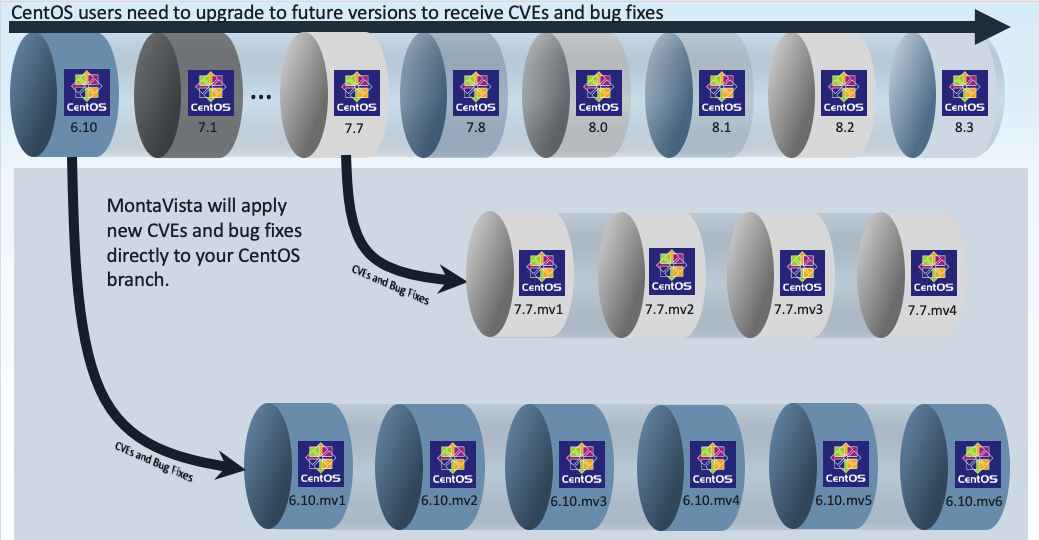CentOS 6.10, all good things need not come to an end
When CentOS 6 was announced to go end of life (EOL) with the 6.10 release, some probably thought “well, all good things must come to an end.” It didn’t take long, but the frantic notices, blogs, and community warnings about upgrading immediately came out and now engineering teams are scrambling to firm up and implement migration plans to CentOS 7 or 8. Or maybe even other Linux platforms. Many probably begrudgingly, as CentOS 6 has served them well, with their products mature and stable. Moving to a newer CentOS platform will cause time consuming migration planning. Engineering execution resources will need to be allocated with possible retesting of a product or solution that was stable, secure, and enjoying high customer satisfaction.
But what if CentOS 6.10 support need not end? This could give product teams breathing room to implement a more controlled and planned migration strategy for their customer base, and more importantly extend life into an already viable solid product.
How can this be accomplished? If you wanted to do this in-house (since the CentOS community will not support after November) it would entail creating a continuous integration platform and team comprised of:
- The good stuff: CVE and bug identification process and engineering team to pull and verify
- The experts: Package, toolchain, and kernel experts to integrate, backport, and troubleshoot (seems trivial but it is not)
- The foundation: Infrastructure and daily/weekly/monthly build execution team
- The core quality: Quality Assurance Test platform (test harness, reservation system, content, execution, and analysis) and test team
- Finally, the product release team
While not impossible to assemble, the depth and expertise can take time to put together and will definitely impact other development plans. Suffice it to say, this cannot be done by one or two engineers, even on a full time basis.
Or you can look to MontaVista Software and get all the CentOS maintenance expertise needed. MontaVIsta Software is now providing extended support for your EOL CentOS 6.10 Linux branch. We have created a highly efficient Continuous Integration/Continuous Delivery (CI/CD) infrastructure. This allows us to pull in CVEs, apply them to various Linux branches(i.e. ours, CentOS, etc.), do backporting if needed, build and then put through a robust QA test cycle. We have the technical expertise and deep support knowledge that understands the nuances of backporting, package maintenance, distribution integration, and testing. We are Linux experts (that are hard to come by) and it takes years to develop and attain our level of Linux CI/CD knowledge.
MontaVista has been providing long term extend Linux support for our embedded Linux distributions since 1999. Our typical product lifecycle is 10 years, but we have some products that we have been supporting for well over 15 years.
Since 2013, MontaVista has been supporting CentOS. MontaVista will maintain CentOS branches (6.10, 7.5, 8.1, etc.) with CVEs and bug fixes. This maintenance is done for the customer’s specific CentOS branch, meaning MontaVista will apply and if needed backport emerging CVEs to your CentOS branch. This is a departure to standard CentOS that requires one to upgrade to newer CentOS versions to pick up CVEs and bug fix patches. (See Picture 1 below). So if you are currently deploying products based on CentOS 6.10, you can stay on this distribution as long as needed while continuing to receive needed security updates. MontaVista can also provide a Service Level Agreement (SLA) to ensure fixes for high priority CVEs for CentOS 6.10 in a predetermined workaround or fix time period.

Picture 1
Extending your CentOS 6.10 support gives you many options and benefits. First, your CentOS 6 based product can continue to be sold and supported, lengthening your revenue stream, - increasing profit margins and and customer satisfaction. In fact, if you use MontaVista, we can continue supporting the CentOS 6.10 branch for as long as your customers demand. Now, with the EOL “spectre” no longer hovering over your product lifecycle, you can strategically plan how to migrate your current customers to new products and solutions based on newer versions of CentOS. This allows your engineering team to assess the migration or new product development cost and schedule. More importantly if you use MontaVista to support your CentOS 6.10 branch, the new product strategy gets your full engineering talent and development staff as it will not be distracted with CentOS 6.10 maintenance issues.
November 30, 2020 is approaching fast so if your current products use CentOS 6.10, you will have to make a choice on how to support going forward. By working with MontaVista, with its CI/CD expertise and CentOS services, you can keep a good thing “going” for a little while longer.
To find out more about MontaVista's MVShield for CentOS, you can find more information here. Or contact us if you want to discuss how to keep your CentOS 6.10 based product updated, secure, and viable.















